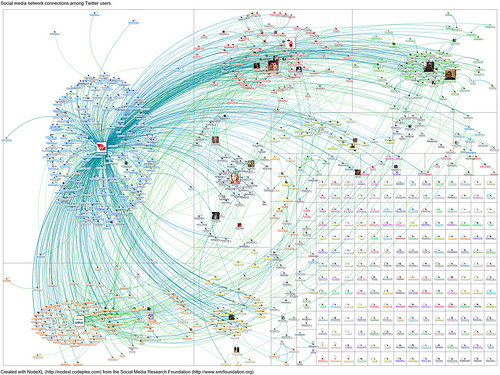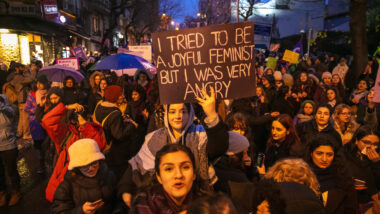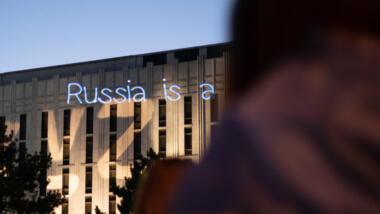This article of political and social scientist Stefania Milan was originally written for the book „Critical Perspectives on Social Media and Protest – Between Control and Emancipation“, edited by Lina Dencik and Oliver Leistert (Rowman & Littlefield, 2015). We’re publishing it here in a shortened version with permission from the author, editors and publishers.
We will also publish a German Version.
Mobilizing in Times of Social Media – From a Politics of Identity to a Politics of Visibility
7 January 2015: The hashtag #JeSuisCharlie („I am Charlie“) became a trending topic on the microblogging platform Twitter. In about a half hour, over twenty-one thousand tweets commemorated the victims of the attack against the French satirical magazine Charlie Hebdo, which left twelve people dead. In the weeks that followed, thousands of people took to the streets in various European cities, holding up signs with the same slogan. But the hashtag did not just express support for those killed. It also signaled the ultimate adhesion to the core values of Western democracy, freedom of the press above all.
Similarly, other hashtags emerged, in support of diverse viewpoints on the same events: For example, #JeNeSuisPasCharlie questioned the contradictory „neo-liberal nod of solidarity“ that reduced the Paris killings to a mere attack on freedom of speech, ignoring the socio-historical background that nurtured the conflict; #JeSuisAhmed honored Ahmed Merabet, the Muslim policeman of Algerian descent fallen in the attack.
25 February 2015: The hashtag #Maagdenhuisbezet („Maagdenhuis occupied“) rapidly went trending on Twitter. It referred to the „appropriation“ by students and staff of the central building of the University of Amsterdam, the biggest in the Netherlands. They protested against the proposed budget cuts to the School of Humanities, and called for „a new university“ not ruled by profit. However, the hashtag was also a reference to the 1969 occupation of the same building – an event that triggered a reform process that resulted in 1971 in a new law affirming the involvement of both faculty and students in the governance of the university. In other words, the hashtag was evocative of perceived commonalities between the 1969 movement and today’s, as well as an omen for radical change to come.
Social media have become a relentless presence in our life. At the end of 2014, there were two billion active social media accounts out of a total three billion internet users, corresponding respectively to the 29 percent and the 42 percent of the world population. Developing countries are expected to account for most growth from 2016 on. Five hundred million tweets of maximum 140 characters are sent per day, in thirty-three languages, and 79 percent of Twitter accounts are outside the United States – yet Twitter is not the most popular platform. Facebook leads the way, with QZone (available in Chinese only) and Google+ following on the distance.
The identities of both protests and protesters come to life in the myriad of individual and collective narratives that unfold on social media platforms as much as they do in real life, and often simultaneously. I have termed this novel mobilization dynamic „cloud protesting“, in reference to the digital backbone that upholds it.

In the maze of social media
Contemporary organized collective action is deeply affected by a pervasive „social media logic“ determined by „the strategies, mechanisms, and economies underpinning these platforms“ (van Dijck and Poell 2013, 3). Does this social media logic change the nature of contemporary collective action, and if so, how?
We can identify a number of patterns within the current social media regimes, which result in the redefinition of, amongst others, the priority, visibility and popularity of content. These patterns include
- publicity: content and interactions are usually public and traceable, albeit sometimes within the „walled gardens“ of user communities;
- mobility: 77 percent of users access social media via mobile devices, which results in the modification of the temporality, spatiality and frequency of content production and fruition;
- real-timeness: the content uploaded online usually appears on-screen in nearly real time, allowing for a quasi-simultaneity of the action or emotion and its representation;
- datafication: platforms quantify exchanges and interactions, ultimately turning users into profiles and data entries;
- virtual/real copresence: the blurring of the boundaries between virtual and real promotes the superimposition of the two dimensions;
- automated disruption: whereby fake accounts and social bots, that is to say virtual agents performing automated tasks, operate alongside with regular users, potentially distorting their activities and perceptions.
All told, social media impose severe material constraints on their social affordances. They do not simply „enable but not determine“ (Bennett and Segerberg 2013, The Logic of Connective Action: Digital Media and the Personalization of Contentious Politics. Cambridge: Cambridge University Press); they significantly contribute to structure modes of interactions and relationships.
In this context, my notion of cloud protesting might sound woefully contradictory. The centralized and privatized nature of the cloud might not be the best metaphor to indicate the distributed efforts of contemporary mobilizations.
The reference to cloud computing, however, points to a fundamental ambivalence in contemporary collective action, namely its distancing itself from the values and exploitation of digital capitalism, while at the same time overrelying on its products, and social media above all, for the protest’s unfolding, diffusion and survival. In what follows, I explore the main features of cloud protesting, investigating what social dynamics the logic of commercial social media contributes to trigger, why and how.
The mobilization trajectories of cloud protesting
Organizations have historically been the engine of social movements and organized collective action. However, if we look back to the last half dozen decades, we can identify a trajectory that sees the progressive enfranchising of informal groupings, small clusters and individuals. Oversimplifying, this evolution can be seen as a function of the technology that became progressively available over time, and of the communication dynamics such technology enabled. We can distinguish three phases, characterized respectively by social movement organizations, by clusters of networked individuals and by what I have termed the „cloud“.
The first phase was dominated by the text-book social movement organization, which offered straightforward membership on the basis of gender, religion or life cycle (see, for example, Tilly 2009: Social Movements, 1768–2008. 2nd ed. New York: Paradigm Publishers). Its leaders controlled the cultural, ideological and normative production of the movement, and served as a point of contact for mass media and journalists. Movement media (see Downing, John D. H., ed. 2011. Encyclopedia of Social Movement Media. Thousand Oaks, CA: Sage), increasingly popular in the form of free and pirate radio stations, alternative magazines and home-printed pamphlets, remained on the fringes of society, and in the hands of a few „expert“ activists.
In the second phase, which corresponded to the diffusion of the internet in the late 1990s, internal and external communication became diffused and to a degree unfiltered, as so did the cultural and symbolic production of social movements.
Identities and values were produced and reproduced through networked digital communication and increasingly cheap camcorders and computers, in a myriad of self-produced media like websites and autonomous video productions. As a metaphor, the network inspired innovative experiments in horizontal organizing, which resulted in flexible coalitions such as affinity groups, temporary clusters oriented to action and rooted on shared values and objectives (see McDonald 2002: „From Solidarity to Fluidarity: Social Movements Beyond ‚Collective Identity‘ – The Case of Globalization Conflicts.“ Social Movement Studies 1: 109–28).
They existed and operated in the context of broader networks, which often spilled over national borders. They emphasized the role of individuals, their needs, preferences and experiences, as well as their acting together. They gave rise to „experience movements“, which stressed the experiential dimension of individuals and their relationship with others (McDonald 2004: „Oneself as Another: From Social Movement to Experience Movement.“ Current Sociology 52 (4): 575–93). But the advent and mass diffusion of social media in the mid-2000s has paved the way for a third dynamic to emerge, that of cloud protesting, of which social media are an integral part.
If we compare the internet era of experience movements with present-day „spontaneous“ groupings coalesced around social media communities, we can see how the focus on the micro-interactional level of collective action is not new within social movements. What have changed in the time of social media are the magnitude of individual direct interactions (more people can potentially communicate with one another), their frequency (social media are accessed through always-on personal mobile devices) and their breadth (as the boundary between the private quotidian and the political has lost relevance). In addition, the publicity and visibility of this micro-interactional level to both external observers and the participants themselves fosters solidarity and protest diffusion, and facilitates media coverage.
Social media and mobile devices have provided the organizational principle for cloud protesting. Groupings approach „dispersed and individualized constituenc[ies]“ (Gerbaudo 2012, 5: Tweets and the Streets: Social Media and Contemporary Activism. London: Pluto Press. (pdf)) rooted on flexible individual engagement in the first person. They take the form of micro-organizations with variable geometry, clustered around magmatic constellations of preexisting interpersonal connections, interactions and networks. Precisely because the quotidian can hardly be distinguished from the political, these groupings, here labeled „clouds“, increasingly resemble familiar assemblages like groups of friends or communities of interest, where various kinds of nonpolitical content are also occasionally exchanged. Similarly to experience movements, participants do not seek to manifest a group identity (a cohesive, univocal „we“) through action. Instead, they are after „other grammars of action: healing, touching, hearing, feeling, seeing, moving“ – „grammars of embodiment“ (McDonald 2006, 37: Global Movements: Action and Culture. Maldena, MA and Oxford: Blackwell, McKelvey, Fenwick Robert. 2014. „Algorithmic Media Need Algorithmic Methods: Why Publics Matter.“ Canadian Journal of Communication 39 (4): 597–613 (pdf)).

The consequences of visibility
The shift to a politics of visibility promoted by social media brings about both intentional and unintentional forms of presence and publicity, which can have significant consequences on collective action. These consequences affect the relations between movements and the state, but also the internal and external dynamics of a social movement. Both speak to the ambivalent attitude towards publicity, visibility and surveillance which characterizes the contemporary social movement ecology (see, for example, Leistert 2013: From Protest to Surveillance – The Political Rationality of Mobile Media. Modalities of Neoliberalism. Frankfurt am Main: Peter Lang).
Digital surveillance, sousveillance and self-surveillance are three facets of the same phenomenon, which has ubiquitous interactivity at its core. The three have become constitutive elements of protest identities in the time of social media, but they have different outcomes on protest emergence, its development and sustainability over time. Moreover, the politics of visibility bears also consequences on the mobilization dynamics per se.
On the one hand, the evaporation of the group as the necessary precondition for collective action alters crucial interpersonal dynamics typical of social movements, like internal solidarity. On the other, the pursuit of visibility at all costs may override action itself, emphasizing a media-centred definition of the impact and effectiveness of a social movement.
First of all, the exercise of visibility makes movements visible to their opponents, including the state, law enforcement and the secret services. In so doing, it dramatically eases both surveillance and repression. Surveillance is made possible by the collaboration of corporations acting as „regulatory agents, turning private centers of power to state purposes“ (Braman 2009, 34: Change of State: Information, Policy, and Power. Cambridge, MA: MIT Press), but counts also on users volunteering their information while trading privacy for „better“, more convenient services.
Although movements have historically been subject to protest policing and repression, surveillance has now reached new frontiers and the costs of mass scrutiny have decreased substantially (Bankston and Soltani 2014). „Connective surveillance“, as Libert (2015: „The Logic of Connective Surveillance: Distributed Social Movements and the Surveillance State.“ Unpublished manuscript. Annenberg School for Communication, University of Pennsylvania) labeled the surveillance logic enabled by commercial social-networking services, allows authorities to take advantage of this ready-made „surveillant assemblage“ of state and nonstate actors (Haggerty and Ericson 2000: „The Surveillance Assemblage.“ British Journal of Sociology 51 (4): 605–22 (pdf)). Rather than creating a surveillance infrastructure ex novo, the state can simply „bring these systems together into a whole“ (Libert 2015, 9: „The Logic of Connective Surveillance: Distributed Social Movements and the Surveillance State.“ Unpublished manuscript. Annenberg School for Communication, University of Pennsylvania.). On social media, law enforcement can exercise preemptive monitoring, and infiltrate groups by polluting communications. Connective surveillance even makes it possible for authorities to watch and potentially repress movements even before they appear.
Although surveillance has historically been the bugbear of social movements in authoritarian and democratic regimes alike, it seems that nowadays the habit to social media has cleared the activist sphere from this concern. It has also given it an aura of inevitability that is met by a resignation that grazes into indifference. Protesters expose themselves to digital surveillance by merely relying on commercial services or „tethered devices“ (c.f., Zittrain 2008: The Future of the Internet—And How to Stop It. New Haven, CT: Yale University Press (pdf)); they run location services on their appliances, contributing to expand the reach of the surveillance machine. In doing so, they dramatically increase the information available to police forces, secret services and beyond, amplifying the discrepancy in (information) resources between movements and their opponents. But the digital surveillance prompted by the exercise of visibility has also an effect on a movement’s identity, and one that is rarely productive. If on the one hand, surveillance is perceived as inscribed in the medium and thus goes largely unnoticed, on the other hand, the easiness at which one can create a digital persona and the activity of bots hinders the collegiality of the group. And while repression normally reinforces the „collective we“, the more subtle surveillance generates suspicion in the long run. It is detrimental to internal deliberation and political participation more in general, and may foster self-censorship.
In the second instance, the emphasis on visibility contributes to create internal boundaries and identify insiders and outsiders through citizen-initiated unmasking based on presence and publicity, possibly subverting the internal cohesion of a movement. Social media, in fact, enable novel forms of self-surveillance, whereby a movement can watch its borders and engage in a game of inclusion and exclusion that ultimately contributes to reinforce the „collective we“. But it is a double-edge sword: while self-surveillance contributes to define the „we“, it paves the way to unhealthy collaborations between a movement and those in charge of watching and repressing it. Self-surveillance becomes particularly dangerous when it intersects a tactic widely used by law enforcement, namely the attempt to take advantage of internal divisions to break a movement. Not surprisingly, authorities increasingly sponsor self-surveillance asking activists to collaborate in unmasking fringes that are considered violent or subversive. As such, self-surveillance functions as a Trojan horse: used by both activists and law enforcement, it is enacted by the former to the benefit of the latter. It allows police forces to outsource some of their prerequisites and tasks and take advantage of the activists’ insider knowledge. It also breaks the traditional separation between protesters and the state, subverting the rules and the roles of the protest game; it may even have deep consequences on internal solidarity.
The third facet of the regime of surveillance of social media can be traced in the possibility of subversion and tactical appropriation it offers to activists, and sousveillance above all. It is not uncommon nowadays to find protesters filming officers on duty as they police demonstrations and encampments. Thanks to smartphones and digital cameras „re-cording police has never been easier […] neither has publicizing these recordings“ (The Economist 2011). Dedicated applications such as Sukey have been developed to „keep protesters safe during demonstrations“ by exchanging information about police whereabouts and doings (Sukey 2011). Investigating Twitter use during the protests against the 2009 G20 meeting in Pittsburgh, United States, (Earl et al. 2013. „This Protest Will Be Tweeted. Twitter and Protest Policing during the Pittsburgh G20.“ Information, Communication & Society 16 (4): 459–78.) have shown how the microblogging service was extensively used to broadcast information about police action, including particular units, weapons or equipment, as well as about interactions with protesters. Other examples of tactical use of the politics of visibility include using surveillance on social media to the advantage of movements, deliberately misrepresenting actions, plans and motives to mislead authorities. On the whole, engaging in sousveillance and subverting state surveillance can have a productive effect on movements. As the creation of a shared identity implies also the identification of a „them“ in opposition to the „we“, monitoring practices to „police the police“ and other tactical uses of surveillance are likely to reinforce a group’s identity and cohesion.

Finally, it is worth looking briefly at the consequences that the transition to a politics of visibility has on movement dynamics, both internal (between members) and external (between activists and bystanders). Visibility becomes a proxy for the „collective we“ at the expenses of critical group dynamics such as commitment, internal solidarity and responsibility towards fellow activists (c.f., Hunt and Benford 2004: „Collective Identity, Solidarity, and Commitment.“ In The Blackwell Companion to Social Movements, edited by David A. Snow, Sarah A. Soule and Hanspeter Kriesi, 443–547. Oxford: Blackwell). While the cloud supplants traditional assemblages in providing activists with a (loose, wavering) sense of belonging, it demands less responsibility towards the collective component: In other words, it offers identification but comes with no strings attached.
The somewhat marginal role of the group in a process that starts and ends with the individual and posits the „collective we“ as a mere intermediary stage, might in the long run have dramatic effects on the sustainability of movements, as well as on their internal cohesion. But the politics of visibility affects also movement tactics and the very definition of what constitutes impact and effectiveness. The quest to capture and record protests and other forms of joint as well as individual action in order to render presence visible („I was there because I have content to show I was there“) results in presence being ranked well above actual action. Self-expression might be privileged over self-organization, and presence may well remain exclusively digital. In turn, impact and effectiveness might be defined solely in terms of media visibility, without this necessarily reflecting a growing attention by policy makers. And while the current fascination of mainstream media for anything social media-related plays in the hands of these distorted dynamics, movements might have to reinvent themselves when media attention is over, or otherwise disappear.
Conclusion
There is a certain type of mobilization and collective action „built into“ social media, which is the direct consequence of the specific regime of materiality brought about by social networking services. Social and mobile media have offered the organizational principle for the emergence of a novel mobilization dynamic, which I have termed cloud protesting. They reshape the process of identity building, promoting a politics of visibility that builds on materiality, publicity and reputation as they are enhanced by social media, and emphasizes experience over belonging. The mobilization trajectory identified by cloud protesting starts and ends with the individual and its mediated self-representation. The „collective we“ is reduced to an intermediary stage, a filter that offers a flexible context to self-contained selves. Visibility has become a proxy for collective identity.
It is undeniable that social media have some merits, too. They have enlarged the normative debate to sectors of the population difficult to reach otherwise; they have brought protest under the spotlight of mainstream media with a minimum outflow of human resources. Yet, the protesters’ overreliance on commercial platforms is a harbinger of the lack of a much-needed critique of shifting power dynamics in the capitalist internet. Not only is it contradictory vis-à-vis the values progressive activists profess; it is also a missed opportunity to exercise reflexivity and self-organization in the com- munications realm, rather than solely self-expression.
The German radical tech collective Nadir has plead fellow activists to abandon the „Trojan horse“ of Facebook, „the most subtle, cheapest and best surveillance technology available“ and a true „political enemy“. „The chatter on Facebook reproduces political structures for the authorities and for companies“, Nadir wrote. „Activist Facebook users feed the machine and thereby reveal our structures – without any need, without any court orders, without any pressure. […] They expose structures and individuals who themselves have little or nothing to do with Facebook. We see Facebook users as a real danger for our struggles.“ It is a plea worth listening to.





0 Ergänzungen
Dieser Artikel ist älter als ein Jahr, daher sind die Ergänzungen geschlossen.